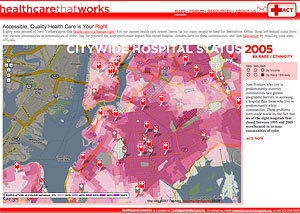March 2007
Map Junk
On Vertederos Localizados Por Los Internautas, the Spanish newspaper La Voz de Galicia invites readers to send in photos and descriptions of illegal garbage dumps. Photos and descriptions are plotted on an interactive map of the country. The intent seems to be embarrassing officials into cleaning it up.
Built by coder Jim Nachlin and friends, the Garbage Scout plots some of the things New Yorkers are throwing out, so that others may claim them. (Many of the shelves in my apartment were inherited from the street.) Sadly, the experiment only lasted a year, though I hear the code may be GPL’d soon.
It’s interesting to me that two maps with the same interaction and functionality and with similar focus can have such different approaches — one top down, the other bottom up.
The Food Bill
From an interview with Michael Pollan, author of The Omnivore’s Dilemma:
“There’s no question that the way we eat is in large part determined by legislation, the Farm Bill in particular. There’s a set of rules for the food system, and those rules are written into the Farm Bill. Most of us are unaware of this bill and don’t understand how this whole system works. The reason that fast-food is so cheap is in large part because we subsidize the growing of corn and soybeans, which are turned into livestock feed very cheaply, and the former into a very cheap sweetener, in the case of high-fructose corn syrup. So we unwittingly made a set of choices, without any of us really being consulted about how we would eat. It’s no accident that this is a fast-food nation. Policy has a lot to do with it. So if you’re going to change the food system, there is a lot that you, the consumer, can do on your own; but in the end, it will be very important to make changes at the national level.
...I think the people involved don’t want anyone else getting involved. It works really well for them that it’s treated as a parochial piece of legislation only of interest to the senators from Iowa or Nebraska or Illinois. Part of it starts with calling it the “Farm Bill.” Nobody thinks that farming is their issue. They think it’s a piece of legislation of interest to farmers. It should be called the “Food Bill” because it really is about how we get our food. People aren’t aware of the impact of this piece of legislation. If they were, they would pay more attention, and there would be a larger political debate around it. I’m hoping this year there will be.”
It occurs to me that there’s a strong parallel between much action and writing about progressive food and sustainable design. Both seem to focus heavily on personal choices and per project consumption: consuming only vegetables, buying organic or local, vs. consuming only recycled paper, non-toxic printing, using sustainable materials or energy. Along the lines of this previous item, I think these gestures are fine and good, certainly we should become the change we want to see. But surprisingly few concerned eaters and designers turn their attention to policy or legislation.
Community projects will focus on urban farming, making homes energy efficient, reproductive health, transportation systems , education, and design for people with dementia. This looks like a grand convergence of the last few years of work by the UK Design Council.
“How are terror and counterterrorist networks visualized? How can we locate and visualize their clandestine operations and network structures, both on a real and virtual level? And how does the visualization of these networks correlate to an operational strategy of symbolic violence, coercive intimidation and political fear?”
Other People
Where design meets activism, one often runs into questions of persuasion.
Via Mike’s snippets I found Following the Crowd to Save the Planet, an article on influence, persuasion, and the social psychology of environmental action. In a nutshell, though people rank “because neighbors are doing it” lowest on a scale of motivational reasons for household conservation, actual data indicates that this is in fact the highest.
“[Researchers] placed one of four cards in each guestroom:
- ‘Help Save The Environment,’ with information stressing respect for nature.
- ‘Help Save Resources For Future Generations,’ with information stressing the importance of energy-saving.
- ‘Partner With Us To Help Save The Environment,’ with information urging guests to help the hotel preserve the environment.
- ‘Join Your Fellow Citizens In Helping To Save The Environment,’ stating the majority of hotel guests reuse their towels.
Compared with the first three messages, the final one asking guests to join others increased towel reuse by about 28 percent.
...
But it’s not fool-proof. The scientists erected signs in the Petrified Forest in Arizona. One sign showed a scene of three wood-taking thieves, with text that urged visitors not to take any wood. After passing this sign, park-goers were three times more likely to steal than the average visitor.
‘The subtext message is that everybody is doing it, which legitimizes the behavior,’ [Robert] Cialdini said.
The second sign showed a lone thief with the same anti-thieving text. Passersby were half as likely to steal as those who didn’t read that sign. The secret to a successful deterrent is to avoid validating deviant actions of a small minority.”
(And note the visual overriding the written message!)
See also: “After graffiti calling for Mugabe to be ousted appeared in the bathrooms of an army barracks, the government announced a 300 percent pay increase for soldiers and teachers. ‘It is a way of buying off the soldiers,’ said [opposition activist] Moyo. ‘Mugabe is a terrified man.’”


